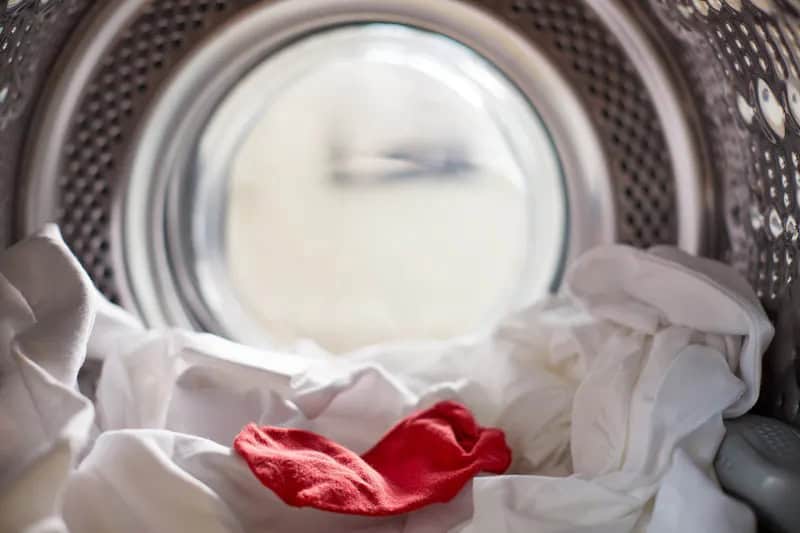On average, people wash their clothes about eleven times a month. A case of ‘child’s play’ you might say. However, there are a few common mistakes when washing that are not so well-known. Do you know them?
⏱ No time to read the whole article? Here are the 8 mistakes to avoid:
- ❌ Mistake 1: Overfilling the washing machine…
- ❌ Mistake 2: …or leaving it too empty
- ❌ Mistake 3: Using too much detergent
- ❌ Mistake 4: Not setting the washing machine upright
- ❌ Mistake 5: Not reading the washing label (correctly)
- ❌ Mistake 6: Not zipping up clothes (or leaving buttons open)
- ❌ Mistake 7: Not choosing the right washing program
- ❌ Mistake 8: Not cleaning the washing machine often enough
Most people have been doing their laundry the same way for years. However, you may need to buy a new washing machine now and then, which will make things a little different. After all, new washing programs can bring some changes, but generally, things go smoothly. Sometimes, things do go wrong. You may not have been aware of these common laundry mistakes. Now you are—and that means you can avoid them from now on!
Error 1: The washing machine is too full
If you put too much laundry in the washing machine, your clothes will be pressed together too tightly. The laundry will spin around in one big mass, preventing the detergent from circulating and dissolving properly. This will result in poor cleaning results. Your laundry will not be cleaned evenly, and stains and dirt will remain, requiring you to wash it all over again.
The Consumers’ Association has investigated the fact that most washing machines are not loaded to the maximum when it comes to weight. But even with less weight, the volume can be large. There is then too little space in the drum. Keeping a hand’s width at the top is a good measure.
Error 2 – Or is the washing drum too empty…?
Another common mistake is to do halfloads, even if your washing machine has a water-saving setting. It may seem more efficient, but it isn’t. A partial load with less water will use almost as much electricity as a full load. That’s why it’s better to only wash when you have a full load. Therefore, keep to the hand width or fist height (see Mistake 1) as much as possible, both at minimum and maximum load.
💡 Some washing machines have a sensor for load recognition. This way you know exactly how much room you still have in kilos. Handy!
Mistake 3: Using too much detergent
More detergent does not make your clothes cleaner. In fact, too much detergent only causes problems, such as clogged pipes because the soap does not dissolve properly. Also, residues remain in the machine, which can start to smell and cause grease lice. In addition, a washing machine with too much detergent uses more energy. This is because the machine has to use more water to process all the soap and foam. Often an extra rinse cycle is also needed – which means you are literally flushing money and water away!
How much detergent you need depends on the amount of laundry and the dirt level. The water hardness also plays a role. The detergent label usually contains dosage advice, but that is for a standard amount of laundry. The recommendation is often quite high. So look critically at what you add to the laundry: is the drum full and is the laundry really dirty?

You can also add (partly) natural home remedies such as vinegar, baking soda or lemon juice to your laundry. These are not only environmentally friendly but often work just as well as some commercial detergents.
Error 4: The washing machine is not level
Of course, a washing machine that makes a huge noise during the spin cycle or even starts to ‘dance’ is not fun. This happens when the machine is not level. The bouncing around is not only quite annoying but can also damage the floor. In addition, it can cause the machine’s supports and shock absorbers to break, leading to expensive repairs.
Luckily, you can easily prevent this. Most washing machines have adjustable feet that allow you to adjust the height of each corner, so you can get the machine nice and level. If you’re not sure whether the washing machine is level, take your time to readjust it. It might take a little time and effort, but it could save you a lot of trouble in the long run.

Error 5: Not reading the washing label (correctly)
Reading the care labels on clothing and other linens is important to find out if a garment is machine washable and at what temperature you can wash it. Start by sorting your laundry by color: light colors, dark colors, and heavily soiled garments. Then sort each pile again by fabric type to use different water temperatures.
💡 Do not wash fabrics that produce lint together with fabrics that attract lint.
If there are not enough clothes for a full load of each type of fabric, in principle all items of the same color can be washed together. In that case, choose the washing program that is most suitable for the most delicate items in the load.
The washing label contains various symbols that all have their own meaning. The wash tub means that you can wash your clothes on a normal program. A wash tub with one line underneath means that it is best to choose an anti-crease program. A wash tub with a broken line is the symbol for the wool wash program (maximum 30 or 40 degrees). The wash tub with a hand symbol stands for quick hand washing, without soaking the garment. A triangle symbol without filling means that clothes can be bleached with any bleach. Want to know more about washing symbols? Then read this article!
Mistake 6: Garments not zipped up (or buttons left open)
If you are going to wash clothes with zippers, close the zippers. This prevents the metal teeth of the zipper from getting caught on other clothes and damaging fabrics. Closing the zippers also prevents the teeth from getting caught on the drum of the washing machine.
Buttons, for example on shirts, are not to be closed. If you do, it can lead to damage to the buttons and buttonholes during washing and drying. When spinning in the washing machine and dryer, pressure can be put on the buttons, causing the thread to become loose and the buttons to fall off. So leave them open.
Error 7: Not the right washing program
If you’ve just bought a new washing machine, it’s tempting to jump right in and throw your laundry in without reading the manual first. But sometimes that manual contains some really useful information. For example, it contains tips on how to maintain your washing machine. And you might learn about functions that you haven’t used before. It also usually contains information about the specific washing programs of your machine.
💡 Cold water works fine in most cases and is better for the fabric. It is also cheaper because heating the water accounts for up to 90 percent of a washing machine’s energy consumption. In general, you can often use less hot water for your washes, unless you are washing clothes that tend to contain more bacteria, such as towels, underwear,and sweaty clothes.
Error 8: The washing machine is not cleaned often enough
It is important to clean your washing machine regularly. When washing your clothes and bedding, mold can build up, also known as laundry lice or grease lice. This can lead to a nasty smell in your machine. It can be a problem especially if you have an older washing machine or wash a lot with cold water, because bacteria can grow more easily.

You can easily clean your washing machine by doing a monthly cleaning round. This is done by running the machine without clothes with hot water and bleach (or an alternative that kills bacteria). This will remove all bacteria and build-up of dirt and detergent residue.
You can also keep your washing machine clean as follows:
-
Unclog the filter by removing it and cleaning it thoroughly with water and an all-purpose cleaner. Read your washing machine manual to see how to remove the filter. Keeping it clean prevents dirt, dust, and clothing fibers from building up and blocking the drain, which can lead to a smelly washing machine.
-
Clean the rubbers around the door of the washing drum regularly with hot water and detergent. For example, letthe all-purpose cleaner soak in for 10 minutes and then wipe it clean with a dry cloth. Then run an empty wash to ensure that the all-purpose cleaner is rinsed away properly.
-
Clean the soap dish by removing the detergent drawer from the washing machine and removing soap residue with hot water and a damp cloth. Don’t forget to also clean the space where the soap dish goes. If necessary, use a toothbrush for hard-to-reach corners.
In addition, it is not a bad idea to leave the door and the soap container of the machine open for a while after each wash, so that the inside can dry properly. This prevents new breeding grounds for bacteria and mold. You can also try to run a boil wash once a month. This removes detergent residue from the machine, especially if you mainly use liquid detergent. Washing powder usually leaves less residue. You can also use a special washing machine cleaner.








